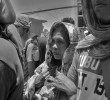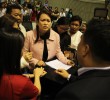By allowing children to speak out and to contribute on the basis of their evolving capacities, disaster work becomes more meaningful as it spells long term action: changing the economic and socio-political landscapes in order to reduce people’s vulnerabilities and increase their capacities for growth and achieving well-being.
By PROF. MAE FE ANCHETA-TEMPLA
Davao Today
Two things about children came to my mind in the aftermath of tropical storm Pablo (Bopha).
One was when I started my social work in the 1980’s, we dealt with children, who were internal refugees at the onset of the Cory Aquino government’s total war policy against the New People’s Army. The conditions of the evacuees and behavior of children brought out the need for social workers like me to comprehensively view the situation, and to study the causes of children’s fears, their restlessness and their psycho-social needs.
Second was that, children of these communities now face a modern-day storm in the aftermath of typhoon Pablo.
While children may not be able to speak out spontaneously about what they see in their social environment, deep inside they have questions that may imply their level of cognition of realities. Left unanswered, these questions may become emotional and psychological issues that will haunt them for life.
At their age, seeing their community now laid flat and barren while adults scream for assistance, these children of the storm are confronted with faces of fear. The loss of significant persons, homes, farms, forests, plants, livestock, pets and playgrounds are overwhelmingly distressing and would leave them psycho-social disturbances and greater insecurities.
Such conditions demand bio-psychosocial help. However, issues of intervention in the lives of families affected by the disasters come into play as disaster responses vary.
Disaster-preparedness was a real problem as local government units were in disarray when Pablo struck. Given that its traditional approach of relief and rehabilitation is limiting the quality of responses, emerging concepts make their way in disaster work. One of this is the community-based disaster management or CBDM.
In the parlance of social development, CBDM is empowering community members to assess disaster risks, and to plan, implement, monitor and evaluate counter-disaster measures. Such strategy is citizen-led and includes social investigation of the nature of disasters in the country and the impact on most vulnerable yet resilient sector: the children.
For decades, people’s organizations in Mindanao have outlined disasters brought about by incursions of the transnational corporations (aided by local officials) such as those into plantations of banana, pineapple, palm oil, logging and large-scale mining. Expansion of these agri-forest businesses and extractive industries see massive opposition from the organized grassroots communities and progressive support groups. Such perspective challenges disaster response by recognizing the need to address the causes of disasters through public advocacy along with education, organizing, direct services and building constituencies towards resolving poverty and concomitant concerns.
It is in this light that CBDM is appreciated as it constitutes pro-active strategies that aim at taking appropriate actions to deal with a disaster even before it happens. As such, it challenges the traditional responses to disasters that are generally reactive through the provision of emergency services such as rescue operation, relief distribution, medical and psychological services, temporary shelter and evacuation.
To reiterate, issues of interventions become critical in today’s disaster response as the people struggle to claim for food, water, first aid for injuries and not to mention debriefing. The magnitude of damage illustrates the kind of preparation made by government agencies. Realities thus demand much more than the kind of disaster response the government and private sectors are undertaking.
Moreover, by treating survivors, especially children, as people with capacities, social development workers in both government and civil society would empower them with their knowledge so that people can build upon their resources for their recovery.
By allowing children to speak out and to contribute on the basis of their evolving capacities, disaster work becomes more meaningful as it spells long term action: changing the economic and socio-political landscapes in order to reduce people’s vulnerabilities and increase their capacities for growth and achieving wellbeing.
Indeed, people must discern that their plight is a product of social inequities and that the resolution lies in the fight against all forms of state-instigated violence. A state that is supportive of foreign control over natural and mineral resources which have caused catastrophic damages to lives, properties and nature, is demonstrating a violent action against its people and the next generation. It breeds children of the new storm — the young who can ferment a different kind of tempest.
Prof. Mae Fe Ancheta-Templa is a women and children rights activist, social worker, peace advocate and chair of the Social Work Program of the Assumption College of Davao, Southern Philippines. Her fields of interest in research include gender, women, children, Moro and indigenous peoples, psychosocial help, community organization, indigenous social work and social administration. She was a research fellow at the University of Cape Town, South Africa.

![[STANDPOINT] Illegal drugs and the NIMBY mindset](https://davaotoday.com/wp-content/uploads/2016/09/Mags-Maglana_UPMIN-Sept.-20-110x100.jpg)








